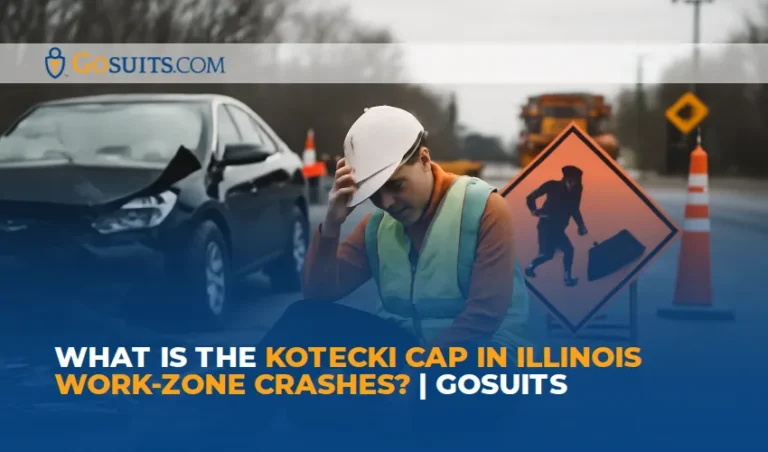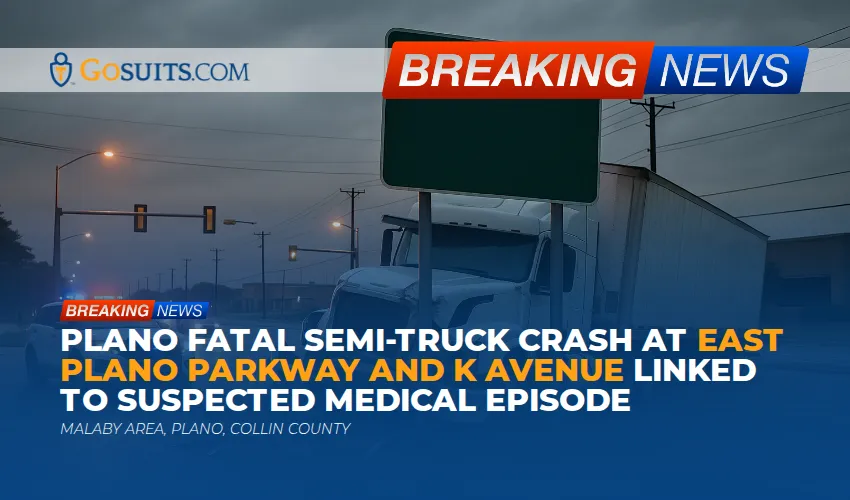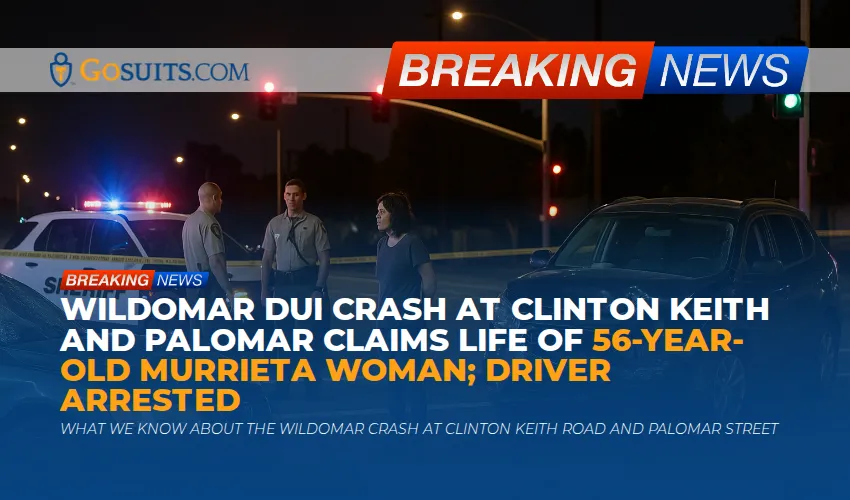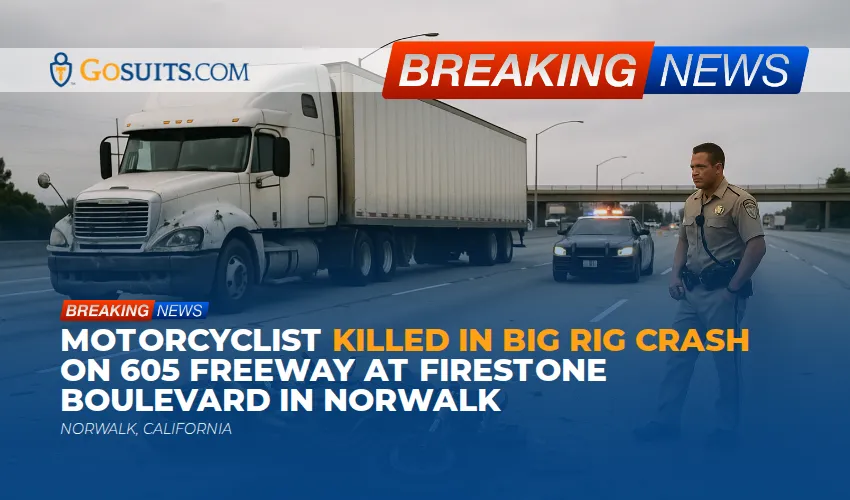- What is the Kotecki cap in Illinois and why does it matter in work‑zone car crashes?
- How do third‑party claims work after a work‑zone crash when you were on the job?
- What is a Section 5(b) workers’ compensation lien and how does it affect your recovery?
- How does the employer contribution limit work under the Kotecki cap?
- When can an employer waive the Kotecki cap in Illinois construction and roadway contracts?
- How do contribution and indemnity differ in Illinois work‑zone crash litigation?
- Who can be liable for an Illinois work‑zone crash besides your employer?
- How do general contractors and road owners face liability in Illinois work‑zone crashes?
- What defenses do third‑party defendants and employers raise in these cases?
- How do settlements affect Section 5(b) liens and the Kotecki cap?
- How do you preserve and discover Kotecki and waiver issues during litigation?
- What damages are available in third‑party cases, and how do liens impact your net recovery?
- What deadlines and venue rules apply to Illinois work‑zone crash cases?
- What practical steps should you take after a work‑zone crash while working?
- How do setoffs, credits, and good‑faith settlements work in Illinois?
- What local FAQs arise in Chicago, Cook County, and surrounding Illinois counties?
- How can GoSuits help you right now with an Illinois work‑zone crash case?
- What sources and references can you review?
What is the Kotecki cap in Illinois and why does it matter in work‑zone car crashes?
The “Kotecki cap” is a judge‑made rule from the Illinois Supreme Court that limits how much a third‑party defendant can recover from your employer in a contribution claim. It comes from Kotecki v. Cyclops Welding Corp., 146 Ill. 2d 155 (1991). In plain terms, if you are injured in an Illinois construction or roadway work‑zone crash while working and you sue a negligent driver, general contractor, traffic‑control subcontractor, or other third party, those defendants may try to shift some of the fault back to your employer. Under Kotecki, your employer’s contribution exposure is capped at the amount of workers’ compensation benefits it owes you under the Illinois Workers’ Compensation Act. That cap can reduce the amount third parties recover from your employer, which can affect settlement dynamics, indemnity demands, and your net recovery after lien resolution.
Why it matters in work‑zone crashes: roadway construction and maintenance sites in Illinois often involve multiple companies, layered contracts, and risk‑transfer provisions. If you were driving a work truck or flagging traffic in a lane closure in Chicago, Cook County, DuPage County, Lake County, Will County, Kane County, McHenry County, or elsewhere in IL, several entities might be involved: the prime contractor, traffic control vendor, subcontractors, the roadway owner, and private motorists. The Kotecki cap influences how those parties apportion fault and money behind the scenes while you pursue your civil claim against third parties.
Work‑zone crashes are a serious safety problem. The Federal Highway Administration reports 956 fatalities in work‑zone crashes nationwide in 2021, reflecting a rising trend over prior years (FHWA Work Zone Facts and Statistics). Illinois transportation agencies emphasize work‑zone safety for workers and the public, including speed enforcement and traffic control in construction zones (Illinois Department of Transportation).
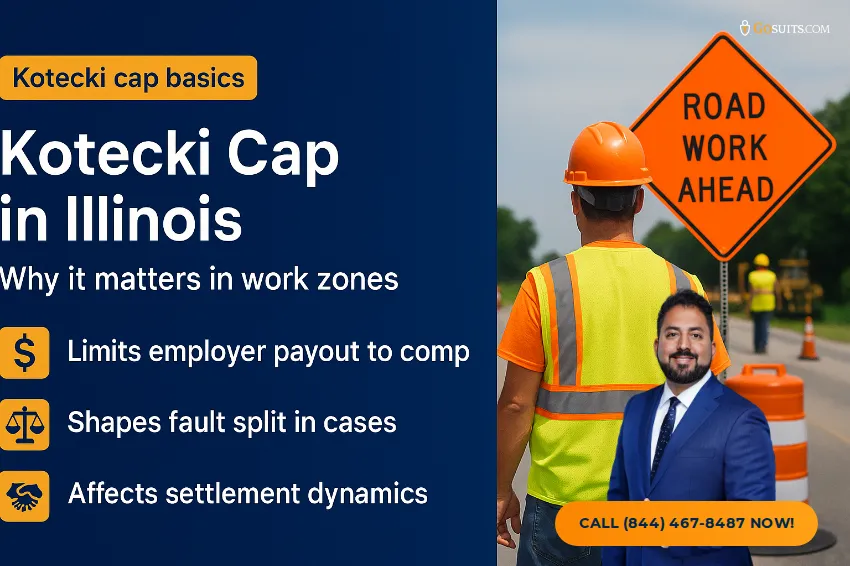
How do third‑party claims work after a work‑zone crash when you were on the job?
If you are hurt while working, your primary benefits come from the Illinois Workers’ Compensation Act. At the same time, you can often pursue a civil negligence claim against responsible third parties. The Illinois Supreme Court confirmed in Doyle v. Rhodes, 101 Ill. 2d 1 (1984), that a negligent third party can sue your employer for contribution, but Kotecki later limited that contribution to the amount of workers’ compensation benefits owed.
How does this apply to an Illinois construction zone car accident?
Consider a flagger struck by an inattentive driver in a Chicago work zone. The worker can file a civil claim against the driver and, depending on the facts, potentially against a contractor or traffic‑control company for unsafe setup. The driver or contractor may file a contribution claim against the worker’s employer. Under Kotecki, that employer’s contribution exposure is capped at its workers’ comp liability under the case.
What is a Section 5(b) workers’ compensation lien and how does it affect your recovery?
Section 5(b) of the Illinois Workers’ Compensation Act gives the employer or its workers’ comp carrier a lien on your third‑party recovery to the extent of benefits paid, with an allowance for reasonable attorney’s fees and costs. See 820 ILCS 305/5(b) (statutory text). In practice, if your civil claim against the at‑fault driver or a contractor settles or goes to verdict, the comp carrier asserts a lien and is reimbursed out of your recovery, less a statutory share for your attorney’s fees and costs.
How large can the Section 5(b) lien be?
The lien typically includes medical payments, temporary total disability, permanent partial disability, and other benefits paid under the Act. Illinois courts have recognized the lien’s broad reach to avoid double recovery, while allowing for statutory fee reductions.
How does the employer contribution limit work under the Kotecki cap?
The Kotecki cap limits the employer’s contribution exposure to the amount of workers’ compensation benefits the employer owes. In litigation:
- If a third‑party defendant brings a contribution claim against your employer, the most it can recover is up to the employer’s workers’ comp obligation under the case.
- If multiple third‑party defendants seek contribution, the aggregate contribution from the employer remains capped at that same comp amount, not per defendant.
- The cap interacts with comparative fault allocations. The jury may assign a percentage of fault to the employer for apportionment purposes, but the employer’s payment is capped as described in Kotecki.
Is the Kotecki cap automatic or must it be pled?
Illinois case law treats Kotecki as a defense that can be forfeited if not raised. Courts have held that employers must plead the cap, and contractual provisions can waive it. See, e.g., Lannom v. Kosco, 158 Ill. 2d 535 (1994) (addressing pleading waiver issues).
When can an employer waive the Kotecki cap in Illinois construction and roadway contracts?
Employers can waive the Kotecki cap by contract. Illinois Supreme Court decisions uphold written indemnity provisions where an employer agrees to indemnify a contractor or owner for injuries to the employer’s own employees, which constitutes a waiver of the Kotecki limitation. See Braye v. Archer‑Daniels‑Midland Co., 175 Ill. 2d 201 (1997); Ioerger v. Halverson Construction Co., 232 Ill. 2d 196 (2008). In many Illinois construction and roadway contracts, subcontractors agree to indemnify the general contractor or owner for employee claims and to name them as additional insureds. Those provisions frequently operate as Kotecki waivers.
What language creates a Kotecki waiver?
Courts look for clear indemnity or contribution obligations that cover employee injury claims. If the contract requires the employer to indemnify a third party for injuries to the employer’s employees, courts have treated that as a Kotecki waiver. Employers and insurers often respond that any waiver applies only to indemnity, not contribution, but Illinois Supreme Court decisions have recognized that a valid indemnity agreement can waive the cap. Whether a particular clause works as a waiver is a case‑specific, contract‑specific question.
How do contribution and indemnity differ in Illinois work‑zone crash litigation?
These remedies are distinct under Illinois law:
- Contribution divides fault among joint tortfeasors so each pays a fair share. The Illinois Joint Tortfeasor Contribution Act governs, including two key features: apportionment by relative fault and discharge of contribution claims after a good‑faith settlement. See 740 ILCS 100/2 (contribution statute).
- Indemnity shifts the entire loss to another party, usually by contract. In construction and roadway contracts, a subcontractor may agree to indemnify the general contractor for claims arising out of the subcontractor’s work, including employee injuries. Valid indemnity provisions can operate as a Kotecki waiver.
Practically, Kotecki caps contribution, but not necessarily contractual indemnity that waives Kotecki. Defendants will examine the contract stack in Illinois roadway projects to identify any Kotecki waiver language.
Who can be liable for an Illinois work‑zone crash besides your employer?
Potential third‑party defendants in an Illinois construction zone car accident can include:
- At‑fault motorists who speed, text, or disobey traffic control in the work zone.
- General contractors responsible for traffic control plans, lane closures, and coordination.
- Traffic control subcontractors that set up signage, cones, channelizers, arrow boards, crash cushions, or flagging operations.
- Other subcontractors whose operations altered safe traffic flow or created hazards.
- Commercial carriers operating trucks or equipment through the work area.
- Roadway owners such as municipalities or counties when alleged negligent maintenance or failure to warn applies, subject to immunities under the Local Governmental and Governmental Employees Tort Immunity Act, 745 ILCS 10/1‑101 et seq.
- Vehicle or equipment manufacturers in defect cases, where appropriate.
How do general contractors and road owners face liability in Illinois work‑zone crashes?
Illinois courts analyze a general contractor’s duty to keep a work site safe based on control, foreseeability, and the nature of the hazard. For retained control over safety means and methods, courts look to principles reflected in Restatement (Second) of Torts section 414, which Illinois courts have discussed in cases addressing contractor liability. Road owners may face claims for negligent maintenance or failure to warn of a dangerous condition, subject to statutory immunities and exceptions under the Tort Immunity Act, including design immunity (745 ILCS 10/3‑103) and the duty to maintain property in a reasonably safe condition (745 ILCS 10/3‑102).
Does compliance with traffic control standards resolve liability?
Compliance with the Manual on Uniform Traffic Control Devices (MUTCD) and applicable IDOT standards is relevant but not always dispositive. Facts about sight distance, queue lengths, taper lengths, speed management, and flagging operations typically require close evaluation by traffic safety professionals in complex cases.
What defenses do third‑party defendants and employers raise in these cases?
- Comparative negligence under 735 ILCS 5/2‑1116, arguing your share of fault reduces recovery, with a 51 percent bar in Illinois.
- Employer fault allocation to reduce other defendants’ shares, even though the employer’s payment is capped under Kotecki.
- Kotecki cap as an affirmative defense to contribution claims against the employer.
- No retained control by general contractors, challenging duty under section 414 concepts.
- Governmental immunities for public entities under 745 ILCS 10/2‑201 (discretionary immunity), 10/3‑102, and 10/3‑103.
- Good‑faith settlement discharge under the Contribution Act for parties who settle in good faith, which bars contribution claims against them.
- Contract interpretation disputes over whether indemnity and additional insured provisions waive Kotecki.

How do settlements affect Section 5(b) liens and the Kotecki cap?
Settlements in a third‑party case intersect with liens and contribution in several ways:
- Section 5(b) lien repayment. The workers’ comp carrier seeks reimbursement from your settlement or judgment for benefits paid, subject to statutory attorney’s fees and costs. 820 ILCS 305/5(b).
- Good‑faith settlement discharge. A settlement made in good faith discharges the settling party from contribution claims. See 740 ILCS 100/2(c).
- Kotecki accounting. If a third party pays a settlement and seeks contribution from your employer, Kotecki limits the employer’s exposure to the comp amount, unless there is a valid waiver.
- Setoffs and credits. Illinois law applies setoffs to avoid double recovery. Allocation among claims, parties, and insurers often requires careful documentation in the settlement agreement.
Can the Section 5(b) lien be negotiated?
Section 5(b) allows for reimbursement less a statutory fee share. Depending on case facts, insurers sometimes agree to compromise a portion of the lien to facilitate settlement. Whether and how much to compromise is fact‑dependent.
How do you preserve and discover Kotecki and waiver issues during litigation?
To properly address Kotecki and related waiver issues, litigants commonly pursue:
- Contract discovery for all prime contracts, subcontracts, purchase orders, and master service agreements related to the project, including insurance and additional insured endorsements.
- Traffic control and safety documents, such as traffic control plans, lane closure requests, pre‑task plans, and IDOT permit provisions.
- Pleadings that assert the Kotecki cap timely on behalf of the employer, and responsive pleadings addressing any asserted Kotecki waiver.
- Rule 213/Rule 214 discovery responses and depositions regarding control, safety responsibilities, and supervision at the work site.
Because Kotecki can be waived by contract and also waived procedurally if not pled, both plaintiffs and defendants monitor these issues early in the case.
What damages are available in third‑party cases, and how do liens impact your net recovery?
In your third‑party civil claim, you may seek damages not available in workers’ comp, including pain and suffering, loss of a normal life, and full wage loss. At the same time, the Section 5(b) lien gives the comp carrier reimbursement rights against your third‑party recovery. The interaction is often summarized as follows:
- Workers’ comp benefits continue regardless of the third‑party claim, but the carrier has a lien on the third‑party recovery.
- Civil damages can exceed comp benefits significantly, especially for severe injury, but your net recovery is subject to lien repayment and any setoffs.
- Apportionment among multiple defendants, insurance limits, and contractual waivers can change who pays what, but should not reduce your right to pursue all legally available damages against third parties at fault.
What deadlines and venue rules apply to Illinois work‑zone crash cases?
- Personal injury statute of limitations. Two years for most negligence claims. See 735 ILCS 5/13‑202 (text).
- Claims against local public entities. One year under 745 ILCS 10/8‑101 (text), with additional Tort Immunity Act provisions potentially applying.
- Claims against the State of Illinois or IDOT. Claims are generally brought in the Illinois Court of Claims, with notice and filing requirements under the Court of Claims Act, 705 ILCS 505. Procedures differ from circuit court practice.
- Contribution claims. The Contribution Act provides timing rules; contribution is often brought in the underlying suit as a third‑party claim, and the statute allows actions within two years after payment in excess of a pro rata share. See 740 ILCS 100/5.
- Venue. Venue typically lies where any defendant resides or where the transaction occurred. See 735 ILCS 5/2‑101.
Deadlines can be shorter for governmental defendants. Acting promptly helps protect your right to bring a third‑party claim and to address lien and Kotecki issues in time.
What practical steps should you take after a work‑zone crash while working?
- Report the injury to your employer and request workers’ comp benefits under Illinois law.
- Preserve evidence by photographing the scene, traffic control devices, and vehicle positions if safe to do so. Identify all contractors and agencies present.
- Request incident and police reports and note any citations issued in the work zone.
- Track medical care and lost income, keeping copies of bills and records.
- Consult with a qualified attorney about your third‑party options, Section 5(b) lien, Kotecki cap implications, and contract‑based waiver issues affecting your case.
You do not have to navigate workers’ compensation, liens, contribution claims, and contract waivers alone. Coordinating the comp claim and the third‑party civil case is essential to protect your rights and maximize your net recovery.

How do setoffs, credits, and good‑faith settlements work in Illinois?
Illinois’ Contribution Act provides that a good‑faith settlement discharges the settling tortfeasor from further contribution claims. See 740 ILCS 100/2(c). Courts decide good faith based on the totality of the circumstances. When some defendants settle, non‑settling defendants are typically entitled to a setoff to prevent double recovery.
For employers, if there is a contribution claim against them, the Kotecki cap limits their exposure unless waived by contract. If an employer’s insurer funds a settlement on the comp lien, parties often account for that payment in the global setoff and contribution analysis.
How can GoSuits help you right now with an Illinois work‑zone crash case?
We know you may be dealing with medical care, time off work, and a confusing mix of insurance calls. Illinois work‑zone crashes combine two tracks at once: a workers’ compensation claim and a third‑party civil case. Then come the hard parts: Section 5(b) lien reimbursement, Kotecki contribution limits, and contract‑based waivers buried in construction documents. Here is how we help from day one.
- Available 24/7 with immediate free consultation. You can reach us any time, day or night. We will listen, spot urgent deadlines, and map next steps immediately.
- Multilingual support. We provide multilingual customer service with 24/7 Spanish and Farsi speakers available. Communication should never be a barrier to getting help.
- No win, No Attorney Fees. We handle injury cases on contingency. Learn more about our policy here: No win, No Attorney Fees. We do not charge hidden administrative fees.
- Coordinated comp and third‑party strategy. We align your workers’ compensation benefits with your third‑party case to protect your income and medical care while working toward full civil damages from responsible parties.
- Contract and insurance analysis. We obtain and analyze the prime contract, subcontracts, and insurance endorsements to identify any Kotecki waiver, indemnity triggers, and additional insured coverage that can add insurance limits to your case.
- Proprietary case software. Our firm built proprietary personal injury software used internally to accelerate investigation, demand preparation, negotiation, lawsuit filing, and discovery. We use technology as a force multiplier to anticipate insurer tactics and move your case forward faster.
- Investigation of the work zone. We gather traffic control plans, lane closure records, contractor safety logs, and crash data. We coordinate with appropriate professionals when needed to evaluate sight distance, taper length, speed management, and flagging operations.
- Experience and results. We bring 30 years of combined experience and have litigated more than 1,000 cases. You can review settlement and verdict results here: past cases. We handle severe injury and complex litigation in Texas, California, and Illinois, and in product liability, 18‑wheeler, brain and spinal injury cases we hire qualified professionals in the state to testify on liability where needed.
- Awards and recognition. Our team’s work has been recognized, including:
- #1 settlements and verdicts across multiple U.S. counties according to TopVerdict
- Top 100 Settlement in Texas
- Sean Chalaki named Top 40 under 40 by National Trial Lawyers
- Recognized by Best Lawyers in 2023, 2024, and 2025
- Selected to Super Lawyers since 2021
- Focused approach. We are not a volume practice. We devote the time your case deserves and keep you informed with regular updates, call‑backs, and transparent timelines.
- Local reach in Illinois. We serve clients across Illinois, including Chicago and the Chicago suburbs in Cook, DuPage, Lake, Will, Kane, and McHenry Counties, and communities such as Naperville, Aurora, Joliet, Rockford, Peoria, Springfield, Champaign, Bloomington, Madison County, and St. Clair County. We can meet virtually or in person, and we have attorneys and staff at our locations ready to help 24/7.
- Immediate action items. We secure police and incident reports, preserve dash‑cam and jobsite video if available, request roadway and traffic control records, and contact insurers so you do not have to. We also coordinate your medical documentation so your claim reflects the full impact of your injuries.
- Community‑minded. We are active in local schools, chambers of commerce, and non‑profit foundations. Team members serve on trial lawyer organization boards, including the Texas Trial Lawyers Association, and participate in consumer protection advocacy groups.
Next step: reach out any time for a free consultation. We will explain how the Kotecki cap, Section 5(b) lien, and any contract‑based waiver may affect your Illinois work‑zone crash case and outline a plan tailored to you.
Sources and references
- Federal Highway Administration, Work Zone Facts and Statistics – national work‑zone crash statistics and safety resources.
- Illinois Department of Transportation – statewide work‑zone initiatives and safety information.
- 820 ILCS 305/5(b) – Illinois Workers’ Compensation Act, third‑party actions and employer lien.
- 740 ILCS 100/2 – Illinois Joint Tortfeasor Contribution Act, contribution and good‑faith settlements.
- 735 ILCS 5/13‑202 – two‑year statute of limitations for personal injury.
- 745 ILCS 10/8‑101 – Tort Immunity Act limitations period for local public entities.
- Key Illinois cases (official citations):
- Kotecki v. Cyclops Welding Corp., 146 Ill. 2d 155 (1991) – employer contribution cap.
- Doyle v. Rhodes, 101 Ill. 2d 1 (1984) – third‑party contribution against employer permitted.
- Lannom v. Kosco, 158 Ill. 2d 535 (1994) – pleading and waiver issues related to Kotecki.
- Braye v. Archer‑Daniels‑Midland Co., 175 Ill. 2d 201 (1997) – contractual waiver of Kotecki.
- Ioerger v. Halverson Construction Co., 232 Ill. 2d 196 (2008) – scope of contractual waiver and indemnity.
FAQs
Does the Kotecki cap apply the same way in Chicago and the suburbs?
Yes. Kotecki is statewide Illinois law, applying in Cook County, DuPage County, Lake County, Will County, Kane County, McHenry County, and other counties. The details can vary by contract language, the identity of public entities involved, and which court hears the case.

What if my work‑zone crash involved IDOT or a municipality in Naperville, Aurora, Joliet, Rockford, Peoria, Springfield, Champaign, Bloomington, Madison County, or St. Clair County?
Claims against local public entities are subject to the Tort Immunity Act, with a one‑year limitations period for many claims, and additional immunities. Claims against the State or IDOT typically proceed in the Court of Claims. These issues can significantly impact strategy and deadlines.
Can a general contractor in a Chicago roadway project force my employer to reimburse them fully?
Only if there is a valid contractual indemnity that operates as a Kotecki waiver. Without a waiver, the employer’s contribution exposure is capped at the workers’ comp amount under Kotecki.
How do Chicago juries handle employer fault when the employer is not a defendant?
Juries can apportion fault to nonparties, including employers, for purposes of contribution among tortfeasors. The employer’s payment is then limited by the Kotecki cap, or unlimited if waived by contract.
